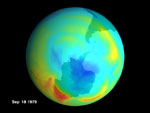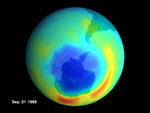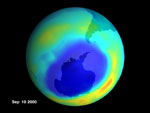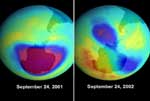|
|
 |
|||
|
A recent report in Auystralia released in September 2005 showed that the ozone hole over the Antarctic was the largest ever on record for the time of year and had appeared earlier than normal. Situation at 2005 October 6 British Antarctic Survey Ozone BulletinThe 2005 ozone hole is one of the deepest and largest recorded. The atmospheric circulation over the Antarctic continent is emerging from its winter state. Stratospheric temperatures have been cold enough for stratospheric clouds to form, and although temperatures are rising they are still widespread. Stratospheric clouds have been observed at Rothera and Vernadsky. There is widespread ozone depletion over the continent, with ozone amounts over 50% down on the normal for the time of year in many places. Lowest ozone amounts are below 100 DU, with all areas of the edge region below 200 DU, though amounts are beginning to rise. The lowest ozone areas are near Halley. Overall the area of the ozone hole is around 22 million square kilometres but is a little smaller in size than the 2003 hole, which was one of the largest on record. It is a little smaller than its peak of 25 million square kilometres in early September. Ozone values at Rothera in September were among the lowest recorded at this time of year, and values around 110 DU were reached on September 11, 19 and 20. The tip of South America and the Falkland Islands were affected by the edges of the ozone hole between August 30 and September 2; September 10 and 12; September 16 and 18; September 25 and 27. During these periods values dropped to over 20% below the normal for the time of year, and most recently have been over 30% down, with values below 200 DU. The region is likely to be affected by severe ozone depletion from October 8 to 10, when ozone amounts may drop 50% below the normal levels. South Georgia is likely to experience low ozone values until October 13. Situation at 2005 September 23-British Antarctic Survey Ozone Bulletin The atmospheric circulation over the Antarctic continent is in its winter state. Stratospheric temperatures are cold enough for stratospheric clouds to form and they have been observed at Rothera and Vernadsky. There is widespread ozone depletion over the continent, with ozone amounts over 50% down on the normal for the time of year in places. Lowest ozone amounts are approaching 100 DU, with most areas of the edge region below 200 DU. The lowest ozone areas are over the base of the Antarctic Peninsula and the Weddell Sea. Overall the area of the ozone hole is around 22 million square kilometres but is a little smaller in size than the 2003 hole, which was one of the largest on record during August. Ozone values at Rothera are amongst the lowest recorded at this time of year. The tip of South America and the Falkland Islands was affected by the very edge of the ozone hole for a few days at the end of August and beginning of September, when values dropped to over 20% below the normal for the time of year.The tip of South America was again affected by the edge of the hole from September 10 to 13. The area is likely to be affected again around September 22 - 25 |
|||
|
In 2001 the ozone hole in the Antarctic covered most of the sub continent. This year in 2002 the hole has separated into 2 holes and widened its effects. This is due to the ozone reaching what is known as a critical mass level which makes it separate due to inner collapse. The problem with this situation is that it will now accelerate and become much larger much quicker and again when it reaches another critical mass level it will split again but into 4 not 3 as the period doubling effect will occur. The time scale for this will depend on amount of pollution that is on its way up and a number of other factors from global warming to oceanic temperature increases to melting of the southern polar ice fields. This is not a good sign and governments around the globe need to look at the necessity for immediate and complete reduction of the use of fossil fuels and other atmospheric pollutants. The USA also needs to stop their pollution agenda and move to bring into play any number of events to stop their domination of the worlds worst polluter. Waiting until something happens is like closing the barn door after the horse has bolted MR. Bush!!! The Antarctic ozone hole split into two holes in September 2002, the first time since satellite measurements began more than two decades ago. The dark blue shading indicates the hole, an area with at least 20% less ozone than normal. This year's ozone hole over the Antarctic is much smaller than it was in 2000, according to NASA researchers. They say it is due to peculiar stratospheric weather patterns and does not indicate that the ozone layer is recovering. "While chlorine and bromine chemicals plus others cause the ozone hole, temperature is also a key factor in ozone loss," Between 1996 and 2001, the ozone hole reached more than 9 million square miles (24 million square km). The 2000 hole was the largest ever recorded at about 11 million square miles (28 million square km), roughly three times the size of the United States.
Here is a link to the Nasa page for more details. http://www.gsfc.nasa.gov/topstory/20020926ozonehole.html Photos courtesy of NASA. . |
|
(c) Copyright 1993-2008 Publishing |
| [Home] [Main index] [Environment] [ozone hole] |
 Ozone hole in 1979.
Ozone hole in 1979. Ozone hole in 1988.
Ozone hole in 1988. Ozone hole in 2000.
Ozone hole in 2000. This is the ozone hole splitting right pic in 2002. Left is 2001.
This is the ozone hole splitting right pic in 2002. Left is 2001.